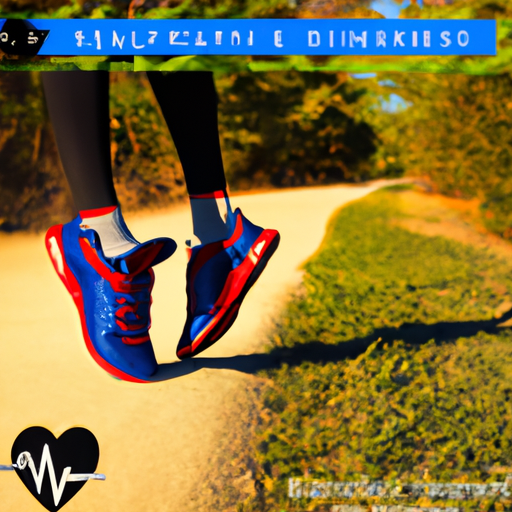If you’re looking to boost your cardiovascular health and maintain a strong heart, regular exercise might just be your secret weapon. With our product, “How To Improve Cardiovascular Health With Regular Exercise,” you’ll discover practical and effective strategies to enhance your heart health. Whether you’re a fitness enthusiast or a beginner, this comprehensive guide will provide you with valuable insights and expert tips to take control of your cardiovascular well-being. Through the power of exercise, you can improve your heart health and ensure a happier, healthier future.
Understanding Cardiovascular Health
Definition of cardiovascular health
Cardiovascular health refers to the overall well-being of the cardiovascular system, which includes the heart and blood vessels. It is characterized by the efficient functioning of the heart, smooth blood circulation throughout the body, and optimal levels of blood pressure and cholesterol.
The importance of cardiovascular health
maintaining cardiovascular health is crucial for leading a long and healthy life. A strong cardiovascular system ensures that oxygen and nutrients are efficiently transported to all parts of the body, while waste products are removed effectively. It also plays a vital role in the regulation of blood pressure and cholesterol levels, reducing the risk of developing cardiovascular diseases such as heart attacks, stroke, and heart failure.
Common cardiovascular diseases and conditions
There are various cardiovascular diseases and conditions that can compromise the health of the cardiovascular system. Some of the most prevalent ones include coronary artery disease, high blood pressure, heart failure, arrhythmias, and atherosclerosis. These conditions can have a significant impact on one’s overall well-being and quality of life if not properly managed.
The Role of Regular Exercise in Cardiovascular Health
How exercise impacts the heart and blood vessels
Regular exercise has profound effects on the heart and blood vessels. When you engage in physical activity, your heart rate increases, allowing more blood flow to the muscles. This increased blood flow helps strengthen the heart muscle, making it more efficient in pumping blood. Exercise also helps expand the blood vessels, improving circulation throughout the body and reducing the risk of developing blood clots.
The relationship between physical activity and heart health
There is a strong relationship between physical activity and heart health. Engaging in regular exercise can help lower the risk of heart disease by improving heart function, reducing blood pressure, and decreasing levels of LDL (bad) cholesterol while increasing levels of HDL (good) cholesterol. Regular physical activity also helps control weight, which is another significant factor in maintaining cardiovascular health.
Scientific evidence supporting exercise for cardiovascular health
Numerous studies have consistently shown the positive effects of exercise on cardiovascular health. Research suggests that engaging in moderate-intensity aerobic exercise, such as brisk walking, cycling, or swimming, for at least 150 minutes per week can significantly reduce the risk of developing heart disease. Strength training, flexibility exercises, and balance training also play important roles in overall cardiovascular fitness.
Types of Exercise for Cardiovascular Health
Aerobic exercises
Aerobic exercises, also known as cardio exercises, are activities that increase your heart rate and make you breathe harder. They include activities such as running, jogging, dancing, and cycling. These exercises focus on increasing stamina, improving heart and lung function, and burning calories. Regular participation in aerobic exercises is a key component of maintaining cardiovascular health.
Resistance training
Resistance training, often referred to as strength training or weightlifting, involves using resistance to challenge the muscles. This type of exercise helps build muscle strength, endurance, and mass. While it may not directly affect cardiovascular health as much as aerobic exercises, it plays a vital role in maintaining overall fitness and preventing muscle loss, which becomes increasingly important as we age.
Balance and flexibility exercises
Balance exercises focus on improving stability and coordination, reducing the risk of falls and injuries. This type of exercise is particularly important for older adults. Flexibility exercises, on the other hand, help improve the range of motion in joints and muscles. Although balance and flexibility exercises may not directly impact cardiovascular health, they provide additional benefits when combined with aerobic and resistance training.
The Benefits of Aerobic Exercises for Heart Health
Effect of aerobic exercises on heart rate
Aerobic exercises have a significant impact on heart rate. During exercise, your heart rate increases to supply enough oxygen and nutrients to the working muscles. Over time, regular aerobic exercise helps lower your resting heart rate, allowing your heart to work more efficiently. This decrease in resting heart rate is a positive indication of cardiovascular health.
How aerobic exercises improve circulation
Aerobic exercises improve circulation by increasing the volume of oxygenated blood pumped by the heart with each beat. This increased blood flow delivers more oxygen and nutrients to the muscles and organs, enhancing their function. Improved circulation also helps reduce the risk of blood clots and lowers blood pressure, both of which are essential for maintaining cardiovascular health.
Aerobic exercises and cholesterol level
Regular participation in aerobic exercises has been shown to have a positive impact on cholesterol levels. It helps raise the levels of HDL (good) cholesterol, which helps remove LDL (bad) cholesterol from the arteries, reducing the risk of plaque buildup. Aerobic exercises also contribute to weight management, which further improves cholesterol levels and cardiovascular health.

The Impact of Resistance Training on Cardiovascular Health
Benefits of strength training for heart health
While aerobic exercises are often credited for their cardiovascular benefits, resistance training also plays a significant role in cardiovascular health. Engaging in resistance training helps improve heart health by increasing the strength and efficiency of the heart muscle. It also improves blood vessel function and reduces the risk of developing cardiovascular diseases.
Role of resistance training in blood pressure management
Resistance training has been found to have a positive impact on blood pressure management. Studies have shown that regular participation in strength training exercises can lead to a decrease in resting blood pressure and a reduction in systolic and diastolic blood pressure readings. This improvement in blood pressure control is crucial for maintaining cardiovascular health.
Effect of resistance training on body composition
Resistance training helps increase muscle mass, which in turn helps improve body composition. Having a higher proportion of lean muscle mass is associated with a lower risk of cardiovascular diseases. Additionally, increased muscle mass improves insulin sensitivity and glucose metabolism, reducing the risk of developing type 2 diabetes, another significant risk factor for cardiovascular problems.
Significance of Balance and Flexibility Exercises in Cardiovascular Fitness
Benefits of balance exercises in cardiovascular health
While balance exercises may not directly impact cardiovascular health, they play a crucial role in maintaining overall fitness and preventing injuries. Good balance reduces the risk of falls, which can lead to fractures or other severe injuries. By minimizing the risk of injury, balance exercises indirectly contribute to long-term cardiovascular health and overall well-being.
Role of flexibility exercises in blood circulation
Flexibility exercises, such as stretching and yoga, help improve blood circulation by promoting the natural flow of blood through the body. By enhancing flexibility in the muscles and joints, these exercises allow for easier movement and proper alignment, which optimizes blood flow and reduces the strain on the cardiovascular system.
How balance and flexibility exercises complement other workouts
Balance and flexibility exercises complement aerobic and resistance training by addressing different aspects of physical fitness. They help improve agility, coordination, and posture, which are essential for performing other exercises safely and effectively. By incorporating balance and flexibility exercises into your workout routine, you can enhance your overall cardiovascular fitness and reduce the risk of injuries.

How to Get Started with Regular Exercise
Determining your fitness level
Before starting any exercise program, it is essential to determine your current fitness level. This can be done by consulting with a healthcare professional, personal trainer, or using fitness assessment tools available online. Evaluating your fitness level will help you choose appropriate exercises and set realistic goals based on your current abilities.
Setting realistic fitness goals
Setting realistic fitness goals is crucial for maintaining motivation and ensuring long-term success. Start by identifying your desired outcomes and breaking them down into smaller, achievable goals. Whether your objective is weight loss, improved cardiovascular health, or increased strength, setting tangible and realistic goals will keep you focused and motivated throughout your exercise journey.
Creating a workout routine
Once you have determined your fitness level and set your goals, it’s time to create a workout routine. This routine should include a combination of aerobic, resistance, balance, and flexibility exercises. Aim for at least 150 minutes of moderate-intensity aerobic activity, 2 or more days of strength training per week, and balance and flexibility exercises on a regular basis. However, it’s important to personalize your routine based on your individual needs and preferences.
Exercise Safety Precautions for Cardiovascular Health
Understanding your limitations
It is crucial to understand your limitations and work within them when engaging in regular exercise. If you have any pre-existing medical conditions or concerns about your cardiovascular health, consult with a healthcare professional before starting a new exercise program. They can provide guidance tailored to your specific situation and advise you on any precautions or modifications you may need to take.
Importance of warming up and cooling down
Warming up and cooling down are essential components of any exercise routine. A proper warm-up prepares your body for physical activity by gradually increasing your heart rate, warming up your muscles, and improving flexibility. Cooling down, on the other hand, helps bring your heart rate back to resting levels and prevents dizziness or muscle soreness. Both warming up and cooling down help promote cardiovascular health and reduce the risk of injury.
When to stop exercising
Knowing when to stop exercising is crucial for ensuring your safety and preventing any adverse effects on your cardiovascular health. If you experience chest pain, dizziness, shortness of breath, or severe fatigue during exercise, it is important to stop and seek medical attention. These symptoms may indicate underlying cardiovascular issues that need to be addressed.

Benefits of Regular Physical Activity beyond Cardiovascular Health
Exercise and mental health
Regular physical activity has numerous benefits for mental health. exercise releases endorphins, which are natural mood-boosting chemicals in the brain. It can help reduce symptoms of anxiety and depression, improve sleep quality, and enhance overall cognitive function. Engaging in regular exercise not only improves cardiovascular health but also contributes to overall well-being.
Physical activity and weight management
maintaining a healthy weight is crucial for cardiovascular health. Regular physical activity, combined with a balanced diet, helps manage weight by burning calories, building lean muscle mass, and improving metabolism. By achieving and maintaining a healthy weight, you can significantly reduce the risk of developing obesity-related cardiovascular conditions.
Exercise and bone health
Regular weight-bearing exercises, such as walking or weightlifting, help promote bone health. Weight-bearing exercises enhance bone density and strength, reducing the risk of osteoporosis and fractures. Strong bones are essential for overall health and can contribute to improved cardiovascular fitness by allowing you to engage in more vigorous activities safely.
Maintaining Consistency and Motivation in Regular Exercise
Tips for consistency in regular physical activity
Maintaining consistency in regular physical activity is key to reaping the benefits for cardiovascular health. Here are some tips to stay consistent:
- Schedule workouts in advance and treat them as non-negotiable commitments to yourself.
- Find activities you genuinely enjoy and mix them up to prevent boredom.
- Set realistic goals and track your progress to stay motivated.
- Create a support system by exercising with friends or joining a fitness community.
- Celebrate your accomplishments and reward yourself for staying consistent.
Ideas for keeping exercise fun and motivating
To keep exercise fun and motivating, consider the following ideas:
- Try new activities or exercise classes to challenge yourself.
- Set fitness challenges or participate in group events, such as charity runs or fitness competitions.
- Use technology to your advantage by tracking your progress with fitness apps or joining virtual workout communities.
- Find a workout buddy or accountability partner to keep each other motivated and accountable.
- Listen to music or podcasts during your workouts to make them more enjoyable.
Dealing with setbacks in workout regimes
Setbacks are a natural part of any fitness journey, and it’s important not to let them discourage you. Instead, use setbacks as opportunities for growth and learning. If you experience an injury or illness that hinders your ability to exercise, focus on proper rest and recovery. Modify your routine as needed and gradually regain your strength and endurance. Remember to listen to your body and seek guidance from healthcare professionals when needed.
In conclusion, regular exercise plays a crucial role in improving and maintaining cardiovascular health. By understanding the importance of cardiovascular health, the impact of exercise on the heart and blood vessels, and the various types of exercises that promote cardiovascular fitness, you can create a personalized exercise routine that enhances your overall well-being. Remember to prioritize your safety by following exercise safety precautions, and embrace the long-term benefits of regular physical activity beyond cardiovascular health. Stay consistent, motivated, and resilient, and enjoy the journey towards a healthier heart and body.



